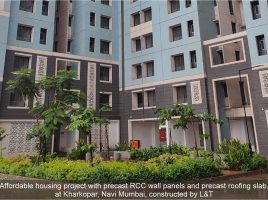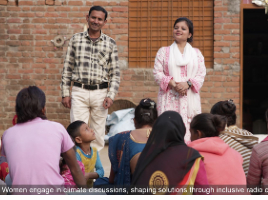From China to India: VSBK’s Low-Carbon Leap

The story of the adaptation(s) of the VSBK technology and brick production processes in India is an example of collaboration among a range of partners coming from varied backgrounds, experience, expertise and skill sets, across formal and informal sectors, from artisans to technical experts and public sector agencies. This was not an academic research exercise, but a designed “action-research” intervention over a period of 10 years from 1996 to 2006. Called The India Brick Project, the intervention was designed to address the high energy and emissions intensity of the brick sector, a booming sector of the economy and one that is not only highly polluting, inefficient and exploitative, but also highly conservative and resistant to change.
The project was initiated by the Swiss Agency for Development Cooperation in India, as part of their programme on response to global environmental challenges. SDC already had a deep engagement with and experience of seeding technology efficiency interventions in the foundry and glass sectors in India and had ongoing intervention to address resource and energy efficiency in the construction sector. In that process, they had identified the potential of the micro, small and medium industry sectors that formed bulk of the economy that provided most jobs outside of the agriculture and governments arenas. Any technology improvement intervention would therefore also need to address the interdependent economic viability and local capacity gaps of the related small-scale sector in India.
The search for technology alternatives took the SDC and the brick sector partners to China. The VSBK was being practiced at a cottage industry level (as tiny informal factories in village backyards), with 50,000 -60,000 such kilns operating informally (by the year 2000) mostly by farmers. This proliferation was aided by the economic reforms that allowed rural industries to be operated privately. While some of these were technically supported by Energy Research institute of the Henan Academy of Sciences at Zhengzhou, most kilns were self-constructed without any guidance, technical standards or norms. They did not therefore exhibit the energy efficiency and environmental control potential that the technology was capable of (as per scientific studies) and mostly demonstrated sub-standard workplace environments, with severe health and safety implications.
The transfer of technology from China to India, its indigenization and appropriation by brick-makers and acceptance of the product by the market with some successes and some failures was organized through a facilitated “action-research” programme. The action research moved from technology transfer and indigenization to techno-social integration and policy influence. SDC brought together independent research and technology development and promotion organizations from India and Switzerland, scientists and firemen from China, local Indian firemen, material and energy scientists, mechanical and ceramic engineers, social scientists, social development organizations, facilitators, commercial brick manufacturing companies, individual entrepreneurs from the traditional brick sector, new business aspirants, brick moulders, firemen, government agencies and financial institutions.
As the technology moved from China to its first pilot in Central India and then to other parts of the country in different social, ecological and institutional contexts, both the production technology and process and its dissemination and advocacy changed to adopt the lessons being generated. Over the period of 12 years there were many changes in the design of the kiln, the selective mechanization of the intermediate processes, the fuel type and chimney design all underwent modifications not only in response to the soil conditions and climate (from Datia in Central India to Odisha in the East, Uttar Pradesh in the north, Pune in Maharashtra in the west to Kerala in the South of the country), but also in response to behaviours and practices of the traditional firemen, brick kiln owners and operators, brick moulder families, market response and the regulatory environment.
The intervention led to substantive technical improvements, such as better ventilation and air-quality from the chimney exhausts, higher fuel efficiency, selective mechanisation of the process to enhance product quality and reduce drudgery. It also led to defining and demonstrating improved operational safety and social supports for workers, new forms of ownership and management and a knowledge sharing platform that brought over 20,000 brick-makers and firemen together.
110 kilns were in operation by 2014 in India (6). These included kilns constructed through the support of the “action-research” project (approximately 20). The dissemination has been slow primarily due to higher capital cost requirement and lower business viability as compared to traditional brick manufacturing systems. Some of the new brick kilns closed due to market and soil unsuitability reasons and some others closed as the new system requires higher fine-tuning of the various elements of soil management, temperature control and loading-unloading methods to maintain desired product quality. Currently, approximately 200 kilns are in operation. Business models range from individual new enterprises, expansion of existing businesses by traditional brick makers, substitution of the inefficient brick making processes by brick businesses, erstwhile worker owned businesses and community based/ group enterprises.
The kiln has undergone many scientific assessments in various geographical locations, for comparative emissions, energy efficiency, operational safety and economic viability at the small scale and output quality. The VSBK in India is now one of the two production methods that are “allowed’ under the National Environment Protection Rules. A result of strong advocacy by the large number of India Brick project members and scientific evidence of its increased energy and emissions efficiency.
The curated but flexible action-research process (albeit limited by funding cycles and reporting requirements) enabled co-designing and co-creation both technological system and of the project itself through workshops, long co-working sessions on the field at kiln sites, and critical review and reflexive analysis of the results by all the concerns members of The India Brick Project.
Such a process results in innovations that emerge as different expertise, experiences, and ways of knowing and working from different contexts come together. This coming together also changes the contexts themselves, offering new windows of opportunity or closure of certain paths as these are no longer tenable. But they build the capabilities, technical, social, and institutional, enabling the institutions and individual actors to redesign the solutions and processes going forward.
References:
- Abbas Akhtar, Sajid Muhammad Bilal, Sajid, Jamshed, Ahmed Naveed, Forecasting environmental and social benefits of adopting cleaner technologies in Indian brick manufacturing industry, Energy for Sustainable Development Vol. 72, February 2023, pgs. 202-211. https://doi.org/10.1016/j.esd.2022.12.001
- Akinshipe, Ola & Kornelius, Gerrit. (2017). Chemical and Thermodynamic Processes in Clay Brick Firing Technologies and Associated Atmospheric Emissions Metrics-A Review. Journal of Pollution Effects & Control. 05. 10.4172/2375-4397.1000190.
- Bhattacharijya Souvik, Assessing social and private benefits and costs for improved brick production in Andhra Pradesh, India Consensus, Copenhagen Consensus Centre, June 2018
- Heirlli, Urs and Maithal Sameer, Brick by Brick : The Herculean Task Of Cleaning Up The Asian Brick Industry, , Swiss Agency for Development and Cooperation ( SDC ),Natural Resources and Environment Division, Berne. 1st Edition : February 2008,
- Opportunities and challenges in converting brick kilns to zig-zag tech, The New Indian Express, E-Paper. 06 Aprli,2024
- VERTICAL SHAFT BRICK KILN TECHNOLOGY (VSBK). Factsheets about brick kilns in south and south-east Asia. www.gkspl.in/whats_new.html; www.ecobrick.in.
[1] Summarised from: Heirlli, Urs and Maithal Sameer, Brick by Brick: The Herculean Task Of Cleaning Up The Asian Brick Industry, , Swiss Agency for Development and Cooperation ( SDC ), Natural Resources and Environment Division, Berne. 1st Edition. February 2008,
[1] “On December 15, 2023, the Ministry of Environment, Forest and Climate Change (MoEFC), Government of India, issued a notification amending Environmental (Protection) Rules, 1986, affecting brick kilns. The notification stated, “The existing brick kilns should convert to zig-zag technology, or vertical shaft or use piped natural gas as fuel in brick making, if they are not using this as of now.” The conversion has to be within one year (starting from 23.2.2023) for brick kilns falling within a 10 km radius of non-attainment cities and within one year of 23.02.2024 for other cities”. Opportunities and challenges in converting brick kilns to zig-zag tech, The New Indian Express, E-Paper. 06 Aprli,2024






Leave a Reply